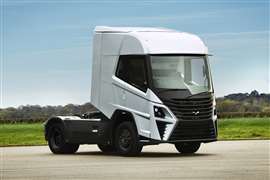‘Miles on wheels’ key to HVS hydrogen fuel cell HGV launch
02 August 2023
 HVS hydrogen fuel cell HGV
HVS hydrogen fuel cell HGV
In April this year, Hydrogen Vehicle Systems (HVS) unveiled its first prototype heavy goods vehicle at the Commercial Vehicle Show in Birmingham, UK. The tractor unit featured a hydrogen fuel cell stack which could deliver an approximate range of 600 km (370 miles), dependent on load and route.
In a related press release, Glasgow-based HVS described the new model as the first ‘indigenous’ hydrogen HGV designed and built in the UK. In the same release, CEO Jawad Khursheed, said: “Thanks to fresh thinking and a ground-up approach, HVS has created an HGV which offers the complete package of game-changing technology and driver ergonomics.”
The reveal of the new truck hides the fine line such startups run between success and failure. In an exclusive interview with New Power Progress and DPI, Khursheed explained how at one stage the company was just hours away from folding. “I was originally brought on as an advisor in 2017, but from there the company almost went into liquidation due to Brexit and COVID. The night before it was to be wound up, I took over the company and set about restructuring the business.”
 Jawad Khursheed, HVS
Jawad Khursheed, HVS
Together with restructuring the company debt, Khursheed says that he brought in what he describes as “the seven company founders”. These experts, some of which have held senior positions in the automotive industry, have effectively donated their time to HVS to ensure the company stayed a viable concern. “Some have worked for 18 months without taking a penny from HVS,” says Khursheed. “That’s how much they believe in this business.”
Keep it simple
A fundamental problem with the original business, says Khursheed, was the plan to build a bespoke powertrain, including the fuel cell stack, battery packs and axles. The funding simply was not there to support such a development path, so the focus switched to producing a ground-up HGV chassis which would be outfitted with components sourced from the wider supply chain.
“Historically, automotive has always been based around hardware with some software. Now, it’s software with some hardware attached. Vehicle efficiency is directly related to software, so we focused on getting the very best of that from our suppliers. We’ll only do one thing and do it well, build the vehicle. And it will be designed to take advantage of the software.”
With this new directive, Khursheed set about raising funds to support the plan. He says HVS pitched 162 different companies before getting a positive response. “I like to think that the 162 presentations were just a warm up for the 163rd, where we finally hit perfection,” he explains with a laugh. That successful pitch was to the EG Group, owners of the Asda supermarket chain, which agreed to deliver £5 million in seed money.
Khursheed set a hugely ambitious 18-month timeframe to build a prototype vehicle, a target which raised some eyebrows across the industry. “We had an OEM come to us and say what you’re proposing to do in 18 months, we couldn’t do in five years. They came back less than 12 months later to ask how we did it.”
Miles on wheels
Khursheed says the company is relying on lean principles to achieve the primary goal - getting vehicles on the road. “It’s imperative that we move fast. We have to be on the road, getting miles on wheels, before all the other truck makers.” He explains that this will allow HVS to establish a foothold in the market, building a reputation as a “trusted and known brand” – and gain sales volumes on the back of that.
If HVS can successfully leverage its built-in agility, this could create a significant advantage. Getting to market early with a fully-operational, type-approved fuel cell truck would effectively position them as the Tesla of the HGV market, where the electric car OEM cornered considerable market share before a viable competitor challenged for the space. Another positive is that the company has no legacy considerations with regards to technology or customers; there is no existing customer base that needs supporting with previous-gen [read: diesel] models or servicing.
“We’re scaling the product, which should allow us to build that market niche and gain market share,” says Khursheed.
He says that there are two key reasons HVS can move so fast. One is that the company will be managing vehicle assembly in-house, with the second being the supporting partnerships put in place to help achieve that production target. “We’re keeping all our IT in-house, which gives us a good starting point,” explains Khursheed.
He declines to say which company is delivering the fuel cell drivetrain, other than it is a global Tier 1 supplier which specialises in the OEM fuel cell market. But he says that the fuel cell has advantages over other versions, in that it is designed to deliver the power required by heavy goods vehicles.
 Internal mirror screens improve aero efficiency
Internal mirror screens improve aero efficiency
Khursheed is keen to highlight that the HVS truck has been designed from the ground up to use a fuel cell powertrain. Where the fuel cell differs from one intended for a passenger car is in basic power (KWh) output. He puts forward that the design of the truck will maximise the percentage of that power delivered to the wheel and road.
“Every part of the vehicle is optimised to be as efficient as it can be to get the maximum from the fuel cell,” he says. “We’re aiming to have the most efficient vehicle on the market. We’re not retrofitting an existing vehicle, which means we can decide the best design for the packaging of the fuel cell hardware and related components.”
 HVS head of Design, Pete Clarke (left), with Jawad Khursheed
HVS head of Design, Pete Clarke (left), with Jawad Khursheed
Designed by Pete Clarke, the exterior design of the truck reflects its hydrogen powertrain. According to Khursheed, where most tractor units from any OEM are about the same length, the HVS model is 800 mm longer. While this helps with fuel tank packaging, he says that it has also helped improve overall aerodynamics at the front of the vehicle, which will naturally increase fuel efficiency and range.
“It’s a unique design, it looks totally different to any vehicle out there,” he states. “It’s imperative that anything we do is focused on the hydrogen elements of the vehicle and getting the best from them.”
The chassis itself is constructed from high-strength steel. Where it might have been considered beneficial to incorporate some elements using ‘exotic’ materials to improve lightweighting and performance, Khursheed says: “We have to pick our battles. We will look at material usage at some point, but doing that now doesn’t get the truck into the hands of our customers. Their key focus is zero emissions and so that becomes our key focus.”
The fuel cell stack is essentially the energy production component in a parallel hybrid powertrain that relies on battery packs to deliver driving power to the wheels. But as those battery packs are being constantly replenished by the fuel cell, those used by the HVS truck are considerably smaller and lighter than those on an equivalent battery-electric vehicle (BEV).
“There are three advantages to using hydrogen,” says Khursheed. “Heavier payloads, quick refuelling and longer range. BEV payloads will always be compromised by the weight of the batteries. Ours is considerably lighter, which means power can be used to carry product instead of moving batteries.”
Artificial intelligence
It could be excused if HVS had chosen to go with anything other than a basic telemetry system in favour of getting a road-ready vehicle to the market. But the same SEMAS system which controls the fuel cell system also delivers critical data with regards to vehicle operation.
 Dashboard displays telemetry info from SEMAS system
Dashboard displays telemetry info from SEMAS system
“Two of the biggest demands from the market are zero emissions and artificial intelligence (AI). Our truck has both,” says Khursheed. “Our philosophy is that every driver should be your best driver and the system supports that goal.”
To explain, he describes a scenario where 10 trucks are driving from Glasgow to London. Two drivers make the journey using a full fuel load, three drivers have to stop for another tank and the final five need to stop for a more. He says the SEMAS system can share telemetry from the best drivers directly between the vehicles to help the less-efficient drivers improve their performance.
“Using a fuel cell improperly will reduce its working lifetime, while every kilogram of fuel used impacts operating expenditure. Using SEMAS, we’re looking to reduce total cost of ownership (TCO) anywhere we can,” adds Khursheed.
Replacing the driver with an autonomous self-driving system could replicate this performance. But Khursheed says while HVS trucks are autonomous-ready, the company is currently involved in development of a hub-to-hub system that will combine autonomous motorway driving with onboard drivers who would move the vehicles from hub to highway and then from motorway to the final destination.
“Ninety-five percent of accidents happen away from motorways. Having a driver take control in city scenarios will ensure the safety of the vehicle and other road users.”
Such systems can clearly have a positive impact on balance sheets, but beyond the environmental benefits there’s no avoiding the fact that fuel cell trucks are prohibitively expensive. Khursheed admits it’s a problem, but he believes it will be a less of an issue in the future.
“All new technology is expensive; look at the first battery-powered cars. Economies of scale have made them so much cheaper. Yes, we understand that fuel cells are very expensive, but once those economies of scale kick in the price will come down significantly. Numbers we’ve seen show that by 2028 or 2029, the TCO of a fuel cell truck and an ICE equivalent will be the same. So we’re only a few years away from parity.”
STAY CONNECTED




Receive the information you need when you need it through our world-leading magazines, newsletters and daily briefings.
POWER SOURCING GUIDE
The trusted reference and buyer’s guide for 83 years
The original “desktop search engine,” guiding nearly 10,000 users in more than 90 countries it is the primary reference for specifications and details on all the components that go into engine systems.
Visit Now
CONNECT WITH THE TEAM










